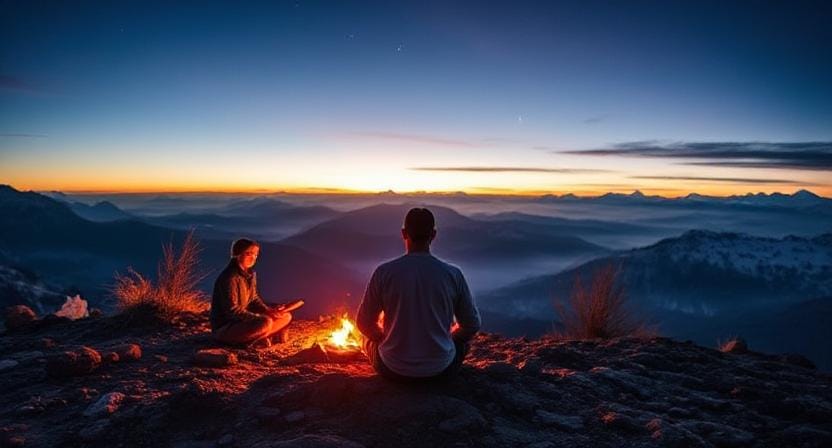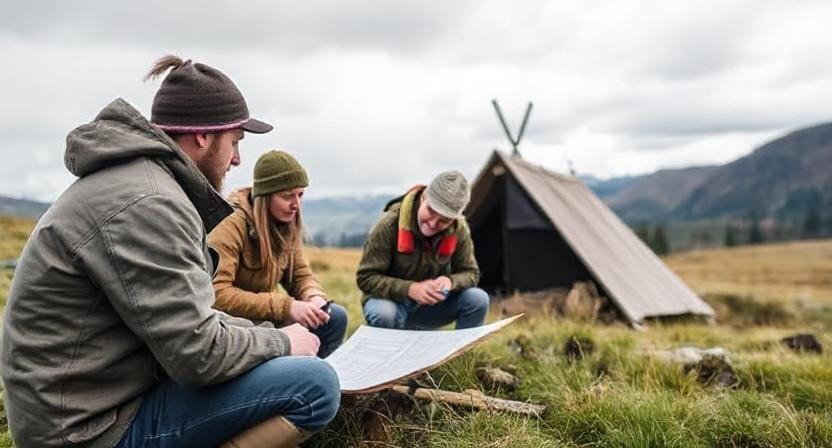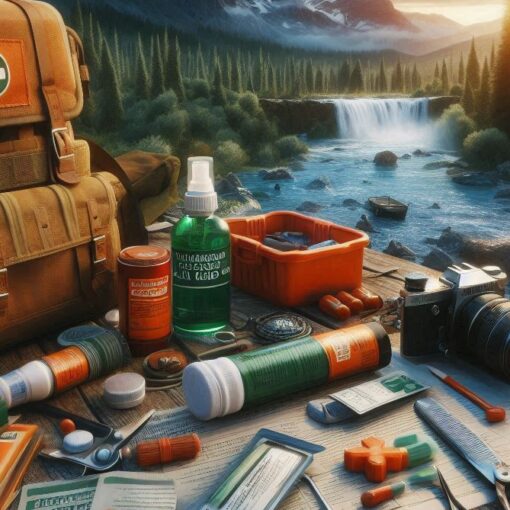Top Takeaways and Key Concepts
- Stay calm and breathe deeply to prevent panic and think clearly during survival situations.
- Acknowledge fear as normal and manage it by focusing on your next smart action.
- Use mindfulness techniques like controlled breathing and sensory awareness to stay grounded.
- Create a simple survival plan with small, achievable steps to regain control and focus.
- Maintain a positive mindset with encouraging self-talk to build confidence and resilience.
Summary of This Article
This article explores the power of survival psychology—how your mindset can make or break your chances in an emergency. It explains that staying calm is just as essential as physical skills like fire-building or shelter-making. The author stresses accepting fear instead of letting it spiral into panic, and using deep breathing, mindfulness, and awareness of your surroundings to stay grounded. Creating a simple action plan helps reduce stress and improve decision-making, while positive thinking and self-belief boost resilience. Finally, the article emphasizes that teamwork and support—whether from others or inner strength—can keep you motivated until help arrives.
Short Video Version of this Article
Think about this. There are tall trees all around you in the woods. You can hear birds chirping and foliage rustling all around you. Then it hits you. You’re lost. You start to panic, like when you open the fridge and see that there is no ice cream left. Ugh.
How can you keep your cool when things seem scary? Welcome to the world of survival psychology! It’s a fancy way of expressing that when things get hard, it’s really vital to keep calm. It’s just as important as understanding how to light a fire or find food, especially if you don’t want to be bear food!
Please Note: This post may contain affiliate links. If you click one of them, we may receive a commission at no extra cost to you. As an Amazon Associate, I earn from qualifying purchases.

Breathe deeply. Just breathe, really. Instead of stressing out, pay attention to what’s going on around you. Look for big rocks or trees that are different from others; these can help you find your way back. Don’t panic; it won’t help at all. It will only make matters worse.
Think about what you already know. Can you build a shelter? Make a fire? When you feel lost, even modest talents can help a lot. And if it gets too much, remember that a lot of others have been in the same boat and gotten through it.
If you stay cool, your thinking will be clearer and you’ll be able to make better decisions. You can do this! If you only take one step at a time, you’ll soon find your way back or know what to do next. Nature is on your side!
The First Step: Acknowledging Fear – Yes, It’s Normal!

Let’s face it: fear is about as welcome as a mosquito at a picnic. But here’s the kicker—it’s completely normal! In fact, if you’re not feeling some level of panic when lost in the wilderness, I’d recommend checking for a pulse. Fear can actually be useful; it heightens our senses and prepares us for action. Think of it as your body’s natural alarm system, yelling “Danger!” while simultaneously making sure you don’t trip over every tree root in sight.
What should we do about this fear? Recognize it instead of letting it escalate into full-blown hysteria, like when I thought I saw Bigfoot (yikes!). Take a deep breath and tell yourself, “It’s okay, I’m scared.” That’s okay. Just mentioning that can actually help things calm down. It inhibits fear from getting out of hand, like when an animal freezes in front of headlights.
Have you ever seen how animals deal with fear? They don’t just stand there and freak out. Nope! They either run away or hide. Clever little things! So think like a squirrel for a moment. Move or find a safe place to stay. But let’s be honest: if there’s a bear involved, running might not be the smartest thing to do.
Instead of staying in that fearful moment, think about what you can accomplish next. Look around to see whether there’s something around that can aid you, like a tree to climb or a trail to follow. Instead of worrying, focus on finding answers.
It’s normal to be worried. Even bold adventurers feel it sometimes! Take a few deep breaths and tell yourself that you can handle anything that comes your way. You can do this!
Staying Grounded – Mindfulness Techniques for Survival

Speaking of squirrels—and staying grounded—mindfulness techniques can work wonders when things get hairy. Let me clarify: mindfulness isn’t just for yoga enthusiasts sipping green smoothies on mountaintops; it’s also handy when you’re trying not to hyperventilate while contemplating whether that rustling noise is an animal or just your imagination running wild.
Focusing on your breathing is a great trick. Like when you’re stuck in a math class that’s too boring (sorry, math enthusiasts). Count how many times you breathe in and out. One, two, three… It helps you relax and protects you from panicking. You might also try counting sheep if that doesn’t work. But only if the sheep are close by and not trying to get away. I mean, who wants to run after sheep that have run away?
Another wonderful suggestion is to use your senses. What do you see? Listen? Do you smell? Take a look around. There could be a lovely flower or the sound of leaves moving in the wind. This activity takes your mind off your worries and reminds you how amazing nature is, even if you’re worried about making it to sunset.
Touch the ground with your feet. Is the grass soft or the dirt rough? Take a moment to enjoy everything around you. The scent of fresh air and the hues of the trees may make a great impact!
Even when things are scary, realize that there is beauty all around you. Paying attention to these small things will help you feel better and bring back some calmness. You can do this! Take a deep breath and search for the little things in nature that amaze you.
Creating a Plan – Because Winging It Isn’t Always Smart

Now let’s talk about planning—a word that strikes terror into many hearts but is essential for survival psychology. When faced with uncertainty, creating a plan gives us back some control over our situation—and who doesn’t love being in charge?
Start by assessing what resources are available: Do you have food? Water? A smartphone with GPS (assuming there’s signal)? Make mental notes of these items so they’re front-of-mind instead of buried under layers of worry about what might happen next.
Next up, let’s make some real steps you can take! If you’ve got water but no food, finding something to eat is super important. Berries are a good choice—yum! Just be careful. Make sure they aren’t poisonous because nobody wants to add “stomach issues” to their list of problems right now. That would be a total bummer.
Think about it this way: having a plan can really help when things get stressful. It turns all that chaos into something manageable. Kind of like organizing sock drawers after too much coffee! You know how messy those can get? Suddenly, it feels less overwhelming when you have a little checklist.
Break things down into small tasks. Maybe first find safe berries, then look for nuts or seeds. If there’s time, think about making a shelter too. It doesn’t have to be fancy—just something to keep you dry and safe from the wind.
Keep reminding yourself that you’ve got this! Each step is like putting together a puzzle. One piece at a time makes everything clearer and easier to handle. Plus, once you start checking things off your list, it’ll feel pretty good!
Positive Thinking – Replacing Doom with Hope

Okay, let’s be real for a sec. Positive thinking isn’t just for those cute posters with kittens hanging from branches. You know the ones? They’re adorable! But when you’re in a tough spot, like stuck on an island, keeping hope alive is super important.
Instead of letting your mind spiral into worries about the worst things—like “What if I never find my way home?”—try flipping that thought around. Think something like, “Hey! Someone’s probably looking for me!” It’s amazing how this little change can help you feel stronger and more ready to face whatever comes next.
Being resilient means bouncing back when life throws us curveballs or even bears! Life can be wild sometimes, huh? So, it helps to focus on solutions instead of problems.
It might sound silly at first, but making affirmations really does work! Saying things like “I am capable” or “I will find my way” over and over can lift your spirits. Kind of like convincing yourself that broccoli tastes wonderful (even if it doesn’t always feel that way).
When you repeat these positive thoughts, they start to sink in. You’ll feel braver and ready to tackle anything ahead. Even if you’re feeling low, those words can remind you that there’s still hope.
Building Connections – Teamwork Makes the Dream Work
Last but certainly not least is teamwork—the ultimate ingredient in surviving any sticky situation! Whether it’s friends or fellow adventurers stranded together—or even friendly forest critters—you’ll need support systems to keep morale high and spirits lifted during tough times.
Talking to other people about your worries is a smart move. Keeping everything inside can lead to a big explosion—like an angry volcano! And nobody wants hot lava flying everywhere, right? Sharing what you feel helps everyone understand each other better. It’s like building a team for survival.
Even if you’re alone out there, remember that nature talks too. Seriously! Just listen closely. Maybe Mother Nature has some wise words hidden in her leaves or maybe she’ll just send a curious squirrel your way, looking for snacks!
Survival psychology sounds tricky, but it’s really about staying calm when things get wild. You know how sometimes life feels like a rollercoaster? That’s chaos! Using your mental strength and leaning on others for support can make all the difference.
You might even have to dodge those phantom bears along the way! They’re sneaky little thoughts that pop up when you’re stressed. Just breathe and remind yourself that you’ve got this.
Frequently Asked Questions
What is survival psychology and why is it important?
Survival psychology is the mental side of staying alive in emergencies. It focuses on controlling fear, staying calm, and making smart decisions. It’s just as important as physical survival skills like building a fire or finding food because a clear mind keeps you safe and prevents panic.
How do I stay calm if I get lost in the wilderness?
Start by taking deep breaths and slowing your thoughts. Panicking makes everything worse, so focus on what you can control. Look around, assess your surroundings, and remind yourself that people survive these situations all the time.
Is it normal to feel scared in survival situations?
Absolutely! Fear is a natural reaction and even helpful at times. It boosts awareness and keeps you alert. The key is to acknowledge it, breathe, and prevent fear from turning into panic so you can still think clearly.
What mindfulness techniques help in survival situations?
Simple techniques work best—focus on your breathing, count your breaths, or use your senses to stay present. Notice what you see, hear, and smell around you. These steps help calm your nervous system and sharpen your awareness.
Why is it important to create a plan instead of acting on impulse?
Acting without thinking can lead to mistakes. A quick, simple plan helps you stay organized and focused. Setting small goals—like finding shelter or water—gives you a sense of control and keeps fear from taking over.
How does positive thinking help during an emergency?
Positive thinking builds mental strength. Replacing negative thoughts like “I’m stuck” with “I can handle this” keeps you motivated. Encouraging yourself with simple affirmations improves confidence and helps you keep moving forward.
What role does teamwork play in survival?
Teamwork increases your chances of survival by combining ideas, skills, and emotional support. Sharing fears and responsibilities reduces stress. Even if you’re alone, staying connected—mentally or through hope—helps maintain resilience and clarity.
Suggested Resources:
Outdoor Survival Skills
https://www.outdoorsurvivalskills.com
The Psychology of Survival
https://www.psychologyofsurvival.com
Wilderness Survival Guide
https://www.wildernesssurvivalguide.com

Kevin Collier is a seasoned outdoor enthusiast and writer for Trekbug.com, specializing in outdoor adventures, survival strategies, and prepping insights. With a deep love for nature and a commitment to self-sufficiency, Kevin empowers readers to embrace the wilderness confidently. He shares valuable tips, practical techniques, and inspiring stories, helping both novice and experienced adventurers develop essential skills for surviving and thriving in the great outdoors.





